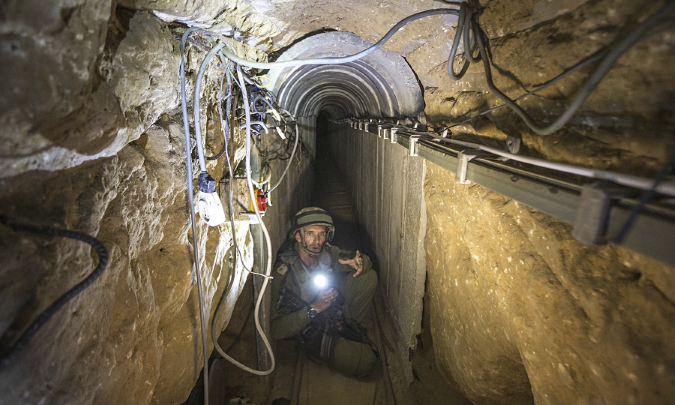HOW TO DEFEAT HAMAS FAST, CHEAP, AND EASY
As the war rages on, Gaza is getting destroyed, people are getting killed on both sides, and a resolution of the conflict seems as elusive as ever. On the contrary, the war is escalating and spreading to other theaters.
Israel is facing two challenging issues: the safe return of the hostages and the eradication of Hamas. Thus far, those issues seemed to be at odds with each other.
According to the reports, the IDF is evaluating two distinct options. The first option involved a full-scale assault on Gaza by infantry and Special Forces supported by tanks, heavy artillery, and aerial bombardment aimed at destroying Hamas positions, the infrastructure, and a wide network of tunnels with deep-penetrating bombs.
The problem with this approach is that the tunnels in Gaza are fairly sophisticated. The massive spiderweb of 300 miles of tunnels boast an impressive level of engineering, constructed from reinforced concrete, divided into separate self-contained sections by steel doors, and reaching depths up to 100 feet. The tunnels are also equipped with modern ventilation systems powered by generators.
They were built under buildings, hospitals, schools, and other civilian projects.
To complicate the matter, many sections following intense bombardments now lie buried under the rubble of destroyed buildings. The rubble provides an additional layer of protection against concrete-buster ammunition. Even if the IDF successfully destroys the tunnels, and it is a big if, there is a fairly high possibility that the hostages will be lost.
The second option is to enforce the blockade and continue bombing while the Biden Administration negotiates with Hamas, using Qatar, a strong Hamas supporter, as a mediator. Under this scenario, the operation cannot begin until the hostages are released. It will be a long and tedious process. Hamas regards hostages as a commodity and a human shield and will not release them until its demands are met.
The terrorists currently hold more than 200 hostages. If they continue releasing two hostages per week, as we witnessed, and doing so keeps the invasion force at bay, it will take approximately two years to secure the release of all hostages. If history is a guide, an agreement negotiated by the US will be the product of Israel making concessions to please the Arabs.
Another point of concern is that Jews have, throughout history, found themselves marginalized and never accepted as an integral part of the global human community. Hamas understands that, in the long run, the world community will not support Israel. We are already witnessing mass demonstrations worldwide supporting Palestinians.
Inevitably, international pressure will pave the way for establishing humanitarian corridors to facilitate aid delivery, evacuate sick and wounded, and provide electricity, water, and other essentials.
At the same time, Israel will face mounting challenges as it endeavors to sustain massive troops and materiel along the Gaza border. The prolonged commitment will weaken the economy, damage Israeli morale, erode confidence in the government, and end with a loss of strategic momentum. Indeed, time is on Hamas’s side.
So, what is to be done? This:
To eradicate Hamas and ensure safe passage for the hostages, the IDF should flood the tunnels with seawater.
If the complete plans of the tunnels with the location of the entrances are not available to IDF, it should not be too difficult to obtain them. This type of tunnel could only be built using professional engineering, procurement, and construction firms. The engineering firms engineered and designed the tunnels, construction firms built them, and various vendors supplied and installed equipment.
All those firms have drawings of the tunnels and, in that part of the world, everything is for sale.
The flooding, if done correctly, will deprive Hamas of a safe harbor in the tunnels and force them out with the hostages where the IDF will be waiting. Even if, by some miracle, Hamas manages to avoid the IDF and leave tunnels undetected, its fighters will still lose the ammunition, rockets, and other military hardware.
At the outset of the operation, it is imperative to convey a clear message to Hamas that only those who get out with the hostages will be spared; the others will be executed on the spot. This time, Israel will manage to separate the so-called civilians from their murderous sons.
Hamas fighters do not wear a uniform or distinguish themselves from the civilian population in some other way, so they are not lawful combatants and are not protected by the Geneva Convention. Israelis should unequivocally convey their resolve by executing terrorists. Terror can be stopped only with greater terror.
The practice of flooding underground installations isn’t a novel concept, and it has historical precedents and a track record of effectiveness. During WWII, Germans used it in Odessa to flush out Soviet partisans concealed in the 1,600 miles of mining tunnels called the Odesa Catacombs.
For Israel, time is of the essence. The IDF needs to flood the Hamas tunnel network now.
Alexander G. Markovsky is a senior fellow at the London Center for Policy Research, a think tank that examines national security, energy, risk analysis, and other public policy issues.


